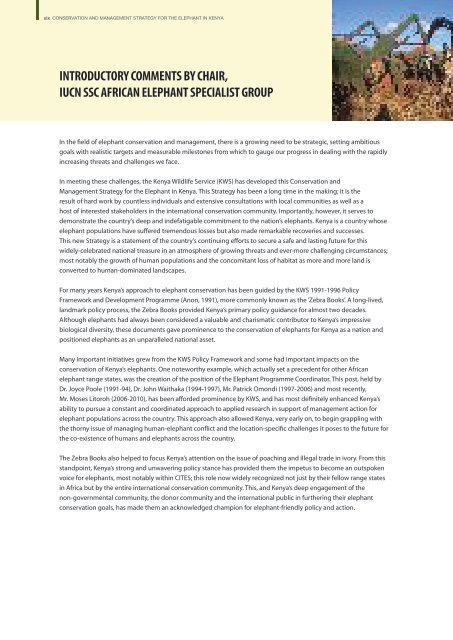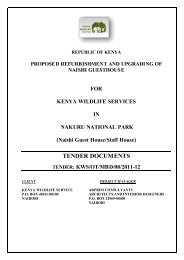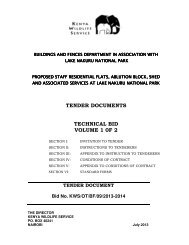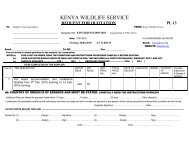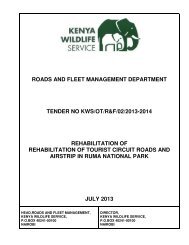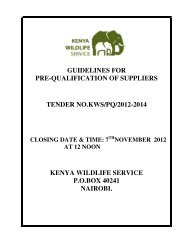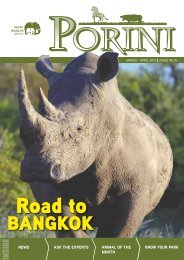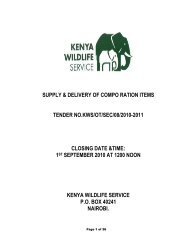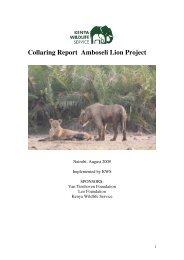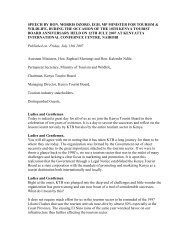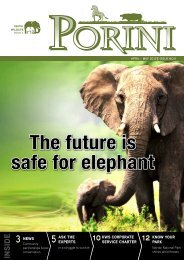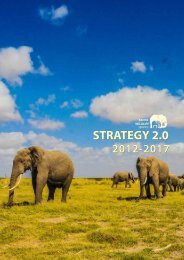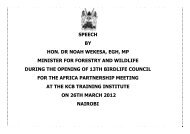Conservation and Management Strategy for the Elephant in Kenya
Conservation and Management Strategy for the Elephant in Kenya
Conservation and Management Strategy for the Elephant in Kenya
You also want an ePaper? Increase the reach of your titles
YUMPU automatically turns print PDFs into web optimized ePapers that Google loves.
xix CONSERVATION AND MANAGEMENT STRATEGY FOR THE ELEPHANT IN KENYA<br />
INTRODUCTORY COMMENTS BY CHAIR,<br />
IUCN SSC AFRICAN ELEPHANT SPECIALIST GROUP<br />
In <strong>the</strong> field of elephant conservation <strong>and</strong> management, <strong>the</strong>re is a grow<strong>in</strong>g need to be strategic, sett<strong>in</strong>g ambitious<br />
goals with realistic targets <strong>and</strong> measurable milestones from which to gauge our progress <strong>in</strong> deal<strong>in</strong>g with <strong>the</strong> rapidly<br />
<strong>in</strong>creas<strong>in</strong>g threats <strong>and</strong> challenges we face.<br />
In meet<strong>in</strong>g <strong>the</strong>se challenges, <strong>the</strong> <strong>Kenya</strong> Wildlife Service (KWS) has developed this <strong>Conservation</strong> <strong>and</strong><br />
<strong>Management</strong> <strong>Strategy</strong> <strong>for</strong> <strong>the</strong> <strong>Elephant</strong> <strong>in</strong> <strong>Kenya</strong>. This <strong>Strategy</strong> has been a long time <strong>in</strong> <strong>the</strong> mak<strong>in</strong>g; it is <strong>the</strong><br />
result of hard work by countless <strong>in</strong>dividuals <strong>and</strong> extensive consultations with local communities as well as a<br />
host of <strong>in</strong>terested stakeholders <strong>in</strong> <strong>the</strong> <strong>in</strong>ternational conservation community. Importantly, however, it serves to<br />
demonstrate <strong>the</strong> country’s deep <strong>and</strong> <strong>in</strong>defatigable commitment to <strong>the</strong> nation’s elephants. <strong>Kenya</strong> is a country whose<br />
elephant populations have suffered tremendous losses but also made remarkable recoveries <strong>and</strong> successes.<br />
This new <strong>Strategy</strong> is a statement of <strong>the</strong> country’s cont<strong>in</strong>u<strong>in</strong>g ef<strong>for</strong>ts to secure a safe <strong>and</strong> last<strong>in</strong>g future <strong>for</strong> this<br />
widely-celebrated national treasure <strong>in</strong> an atmosphere of grow<strong>in</strong>g threats <strong>and</strong> ever-more challeng<strong>in</strong>g circumstances;<br />
most notably <strong>the</strong> growth of human populations <strong>and</strong> <strong>the</strong> concomitant loss of habitat as more <strong>and</strong> more l<strong>and</strong> is<br />
converted to human-dom<strong>in</strong>ated l<strong>and</strong>scapes.<br />
For many years <strong>Kenya</strong>’s approach to elephant conservation has been guided by <strong>the</strong> KWS 1991-1996 Policy<br />
Framework <strong>and</strong> Development Programme (Anon, 1991), more commonly known as <strong>the</strong> ‘Zebra Books’. A long-lived,<br />
l<strong>and</strong>mark policy process, <strong>the</strong> Zebra Books provided <strong>Kenya</strong>’s primary policy guidance <strong>for</strong> almost two decades.<br />
Although elephants had always been considered a valuable <strong>and</strong> charismatic contributor to <strong>Kenya</strong>’s impressive<br />
biological diversity, <strong>the</strong>se documents gave prom<strong>in</strong>ence to <strong>the</strong> conservation of elephants <strong>for</strong> <strong>Kenya</strong> as a nation <strong>and</strong><br />
positioned elephants as an unparalleled national asset.<br />
Many important <strong>in</strong>itiatives grew from <strong>the</strong> KWS Policy Framework <strong>and</strong> some had important impacts on <strong>the</strong><br />
conservation of <strong>Kenya</strong>’s elephants. One noteworthy example, which actually set a precedent <strong>for</strong> o<strong>the</strong>r African<br />
elephant range states, was <strong>the</strong> creation of <strong>the</strong> position of <strong>the</strong> <strong>Elephant</strong> Programme Coord<strong>in</strong>ator. This post, held by<br />
Dr. Joyce Poole (1991-94), Dr. John Waithaka (1994-1997), Mr. Patrick Omondi (1997-2006) <strong>and</strong> most recently,<br />
Mr. Moses Litoroh (2006-2010), has been af<strong>for</strong>ded prom<strong>in</strong>ence by KWS, <strong>and</strong> has most def<strong>in</strong>itely enhanced <strong>Kenya</strong>’s<br />
ability to pursue a constant <strong>and</strong> coord<strong>in</strong>ated approach to applied research <strong>in</strong> support of management action <strong>for</strong><br />
elephant populations across <strong>the</strong> country. This approach also allowed <strong>Kenya</strong>, very early on, to beg<strong>in</strong> grappl<strong>in</strong>g with<br />
<strong>the</strong> thorny issue of manag<strong>in</strong>g human-elephant conflict <strong>and</strong> <strong>the</strong> location-specific challenges it poses to <strong>the</strong> future <strong>for</strong><br />
<strong>the</strong> co-existence of humans <strong>and</strong> elephants across <strong>the</strong> country.<br />
The Zebra Books also helped to focus <strong>Kenya</strong>’s attention on <strong>the</strong> issue of poach<strong>in</strong>g <strong>and</strong> illegal trade <strong>in</strong> ivory. From this<br />
st<strong>and</strong>po<strong>in</strong>t, <strong>Kenya</strong>’s strong <strong>and</strong> unwaver<strong>in</strong>g policy stance has provided <strong>the</strong>m <strong>the</strong> impetus to become an outspoken<br />
voice <strong>for</strong> elephants, most notably with<strong>in</strong> CITES; this role now widely recognized not just by <strong>the</strong>ir fellow range states<br />
<strong>in</strong> Africa but by <strong>the</strong> entire <strong>in</strong>ternational conservation community. This, <strong>and</strong> <strong>Kenya</strong>’s deep engagement of <strong>the</strong><br />
non-governmental community, <strong>the</strong> donor community <strong>and</strong> <strong>the</strong> <strong>in</strong>ternational public <strong>in</strong> fur<strong>the</strong>r<strong>in</strong>g <strong>the</strong>ir elephant<br />
conservation goals, has made <strong>the</strong>m an acknowledged champion <strong>for</strong> elephant-friendly policy <strong>and</strong> action.


